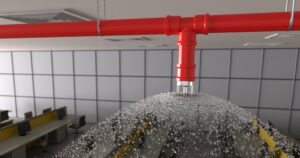Sprinkler systems save lives in case of fire. Along with other active and passive fire protection measures, a well-maintained fire sprinkler system can help suppress smoke and flames. It can also reduce the spread of fire and damage. Generally, it gives everyone time to get out of the building when the fire service arrives. There are four types of commercial sprinkler systems. Each one is adapted according to the needs of different possibilities to maximize the response time and ensure the protection of human life and property.
Wet Pipe System
Pipeline sprinkler systems—or traditional fire sprinklers—are the most common system in residential and commercial buildings. When a fire occurs, the heat activates the nearest system and releases the pressurized water stored in the pipes. Each system activates independently and reduces water damage in the event of a false alarm. Water pipe systems are an inexpensive option that do not require special maintenance. Therefore, they are suitable for offices, schools and commercial buildings.
Dry Pipe System
Unlike wet pipe systems, dry pipe systems do not store water in their pipes. Instead, they are filled with pressurized air or nitrogen. It will be released if the fire activates the sprinkler. The pipes are then filled with water and discharged over the smoke or flames. This system is more complicated and expensive than the wet pipe system. Overall, this system is best suited for cold climates where there is a risk of freezing.
Pre-Action System
Pre-actuator systems are another form of dry pipe system, but require two-stage activation. When heat or smoke is detected, the pre-actuator valve opens, allowing water to enter the pipes. Then, system heads can be activated individually to release water onto the fire. This two-step process allows facilities to shut down the system in the event of a false alarm. Pre-actuator systems are very useful in places where accidental discharge of water can lead to irreparable damage, such as museums, libraries, etc.
Deluge System
Deluge systems are another version of the dry pipe system. However, unlike all the previous ones, the sprinkler heads in this system are always open. This means that they do not have a thermal sensor in the head of the system. These require an external smoke or heat sensor to activate. When heat is detected, water fills the pipes and is released to all ends, creating a deluge effect over the entire area. This system is mostly used in industries with flammable liquids that are likely to spread quickly.
Installing a sprinkler system
This fire protection system is an essential part of a complete fire protection plan for any facility.
While it’s important to understand the differences between the options available, the design, installation, and maintenance of these systems should always be performed by trained professionals such as Manasanat Paydar Sustainable. Once your sprinkler system is installed, the experts at ManaSanat Paydar will work with you to create a maintenance schedule that meets your needs and ensures maximum safety for your employees and property.

